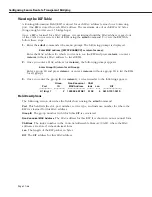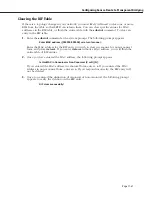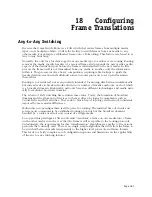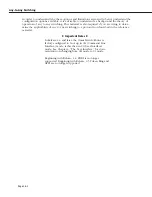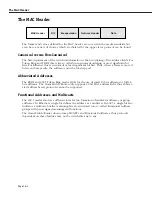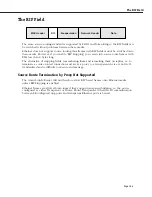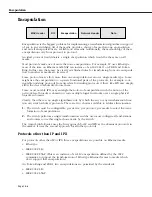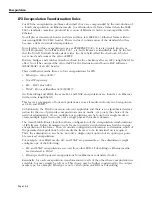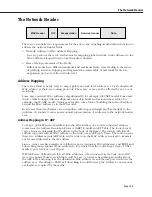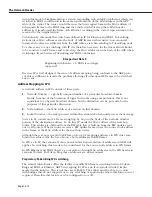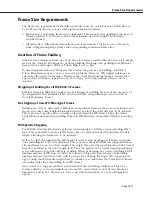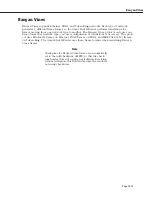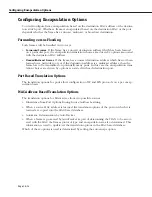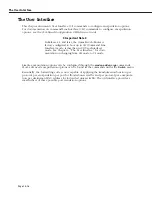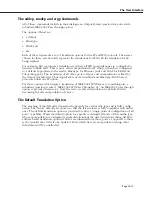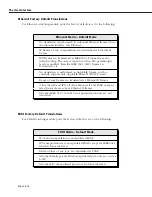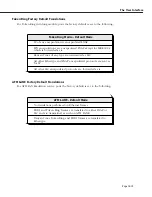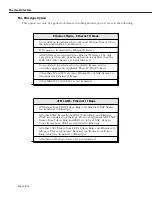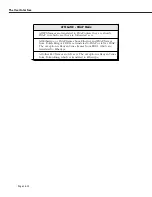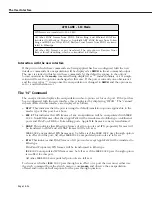
Frame Size Requirements
Page 18-11
Frame Size Requirements
The frame size requirement for the different media cause two problem areas which have to
be addressed by the any to any switching transformation function.
• Ethernet has a minimum frame size requirement. This requires that padding is inserted on
frames switched to it which are below the minimum size and stripped from frames
switched from it.
• All media have different maximum frame size requirements. This gives rise to the prob-
lems of fragmenting large frames and/or negotiating maximum frame sizes.
Insertion of Frame Padding
Ethernet has a minimum frame size of 64 bytes. For frames smaller than 64 bytes it is a simple
task for the Omni Switch/Router to perform padding. Stripping such padding from Ethernet
frames when switching to FDDI or Token Ring is not so easy.
In most implementations of IP that we have tested the presence of padding on FDDI or
Token Ring frames appears not to cause any problems. However, IPX implementations are
adversely affected by its presence. Therefore the Omni Switch/Router takes a conservative
approach
for all frames
, regardless of protocol type, and strips padding
where it can be
detected
.
Stripping of Padding for all IEEE 802.3 Frames.
Ethernet frames in IEEE 802.3 format can be stripped of padding because of the presence of
the length field. This includes all LLC and hence SNAP encapsulated protocols as well as
Novell Proprietary format.
No stripping of non-IPX Ethertype Frames
Padding can only be detected for Ethertype encapsulated frames if the protocol is known and
the protocol has some length information which can allow the valid data size to be inferred.
This is protocol specific and is currently only performed for IPX frames. Thus, the Omni
Switch/Router
does not
strip padding from non-IPX Ethertype encapsulated frames
including
IP
.
IPX Specific Stripping
For IPX the Omni Switch/Router performs pad stripping for all frame types including Ether-
type. This is possible because all IPX frames have a common header that includes the data
length, allowing the frame size to be inferred.
In fact, for IPX, the length in the IPX header is used to strip padding in all frame encapsula-
tions including the 802.3 based formats. This is because many IPX Ethernet implementations
also pad frames to an even byte length. This single byte pad when performed on 802.3 based
frames is included in the 802.3 length field. Thus the generic 802.3 based stripping technique
is not sufficient to strip this odd-byte padding. When performing any to any switching FDDI
implementations of IPX were found to be tolerant of this extra byte whereas Token Ring
implementations would not work with it present. By adopting the single IPX stripping strat-
egy of using the IPX header length these problems are avoided thus the Omni Switch/Router
unconditionally strips all padding from IPX frames.
Also, it
does not
support odd-byte pad insertion when switching to Ethernet. This was a
feature added to overcome limitations of some NIC cards which is now of only historical
importance and in fact, Netware 4.1 servers provide this insertion as a port configuration
option.
Summary of Contents for Omni Switch/Router
Page 1: ...Part No 060166 10 Rev C March 2005 Omni Switch Router User Manual Release 4 5 www alcatel com ...
Page 4: ...page iv ...
Page 110: ...WAN Modules Page 3 40 ...
Page 156: ...UI Table Filtering Using Search and Filter Commands Page 4 46 ...
Page 164: ...Using ZMODEM Page 5 8 ...
Page 186: ...Displaying and Setting the Swap State Page 6 22 ...
Page 202: ...Creating a New File System Page 7 16 ...
Page 270: ...Displaying Secure Access Entries in the MPM Log Page 10 14 ...
Page 430: ...OmniChannel Page 15 16 ...
Page 496: ...Configuring Source Route to Transparent Bridging Page 17 48 ...
Page 542: ...Dissimilar LAN Switching Capabilities Page 18 46 ...
Page 646: ...Application Example DHCP Policies Page 20 30 ...
Page 660: ...GMAP Page 21 14 ...
Page 710: ...Viewing the Virtual Interface of Multicast VLANs Page 23 16 ...
Page 722: ...Application Example 5 Page 24 12 ...
Page 788: ...Viewing UDP Relay Statistics Page 26 24 ...
Page 872: ...The WAN Port Software Menu Page 28 46 ...
Page 960: ...Deleting a PPP Entity Page 30 22 ...
Page 978: ...Displaying Link Status Page 31 18 ...
Page 988: ...Displaying ISDN Configuration Entry Status Page 32 10 ...
Page 1024: ...Backup Services Commands Page 34 14 ...
Page 1062: ...Diagnostic Test Cable Schematics Page 36 24 ...
Page 1072: ...Configuring a Switch with an MPX Page A 10 ...
Page 1086: ...Page B 14 ...
Page 1100: ...Page I 14 Index ...


